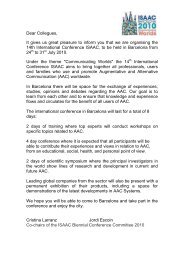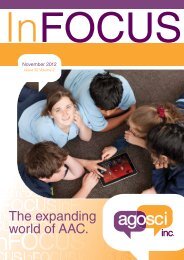May 2008 Edition - agosci
May 2008 Edition - agosci
May 2008 Edition - agosci
You also want an ePaper? Increase the reach of your titles
YUMPU automatically turns print PDFs into web optimized ePapers that Google loves.
ccommunicationo m m u n i c a t i o nppartnersa r t n e r sSupporting Parents... (cont)the need to follow the process rigorously• It gave me an understanding of the background ofthe system, my son’s current need and the futureobjectives.• I feel better informed about how to implement ALS andsupports needed. I feel everything is possible!• I am going to try and remember the prompts and beinvolved in scaffolding eg to pause, use prompts,wristbands etc.• At home, I am now going to use ALS as much as possiblethroughout the day and provide more opportunities forpurposeful communication – conversation as opposedto question/answer activities.• It was useful to appreciate that although my daughtercan sign, has started to talk, she can’t tell me if she hada bad day at day care etc. I feel with this system she willbe able to do that.• Video footage was very encouraging, great examples ofwhat is possible.In ConclusionWe have learnt that we will only see signifi cant improvementsin our children’s ability to communicate with us if ALS withthe child’s own communication systems is being implementedconsistently by their family and other members of their supportnetwork. As early intervention service providers it is ourprofessional duty to keep abreast of all developments that canenable our students to gain greater autonomy in their learning,to develop active, problem-solving ‘can do’ personalities. Foryoung children with complex communication disorders it isour experience that these personalities have the best chance ofdeveloping if parents, professionals working with the children,and ideally the wider community understand what it takes to bea good communication partner and are empowered to becomegood communication partners through explicit training in andfrequent, regular exposure to the strategies of aided languagestimulation.ReferencesBurkhart, L., & Porter, G. (2006). Partner-assistedcommunication strategies for children who face multiplechallenges. Pre-conference Instructional course – InternationalSociety for Augmentative and Alternative Communication(ISAAC) Conference, Düsseldorf.Clarke, M., & Kirton, A. (2003). Patterns of interactionbetween children with physical disabilities using augmentativeand alternative communication systems and their peers. ChildLanguage Teaching and Therapy, 19, 135-151.Department of Education. (2001). Students with physicalimpairment: Augmentative and Alternative Communication.Brisbane, QLD: Author.Goosens’, C., Crain, S., & Elder, P. (1992). Engineering the preschoolenvironment for interactive, symbolic communication:18 months to 5 years. Birmingham, AL: Southeast AugmentativeCommunication Conference Publications Clinicians Series.Hari, M. (1996). The creative brain and conductive education.In M. Taylor & J. Horvath (Eds.), Conductive EducationOccasional Papers Number 3.Hari, M., & Akos, K. (1988). Conductive education. London:Routledge.Jones, L. (2007). Embracing recent advances in augmentativeand alternative communication (AAC), including assistivetechnology, in order to facilitate the development oforthofunction. Conference Presentation, Sixth World Congresson Conductive Education, Gothenburg, Sweden.Kozma, I. (1995). The basic principles and present practiceof conductive education European Journal of Special NeedsEducation, 10, 111-123.Light, J. (1997). “Communication is the essence of human life”:Refl ections on communication competence. Augmentative andAlternative Communication, 13, 61-70.Millar, S., & Aitken, S. (1996). Voice output communicationaids. In N. Bozic, & H. Murdoch (Eds.). Learning throughinteraction. London: David Fulton.Porter, G. (2007). Pragmatic organisation dynamic displaycommunication books. Victoria: Cerebral Palsy EducationCentre.Porter, G., & Burkhart, L. (2004). Designing light tech andhigh tech dynamic auditory scanning systems. ConferencePresentation, ISAAC conference, Natal, Brazil 2004.Porter, G., & Kirkland, J. (1995). Integrating augmentative andalternative communication into group programs: Utilising theprinciples of Conductive EducationWithall, L., & Cotter, C. (1996). Applying principles ofConductive Education in schools: a guide to curriculumdevelopment and delivery. Melbourne: Spastic Society ofVictoria.27





